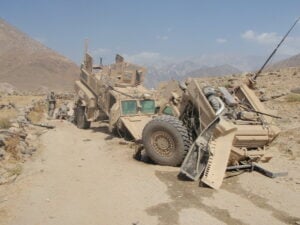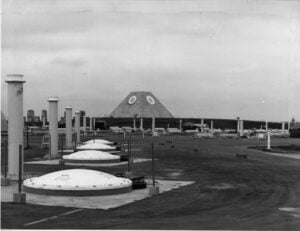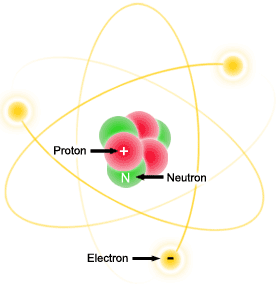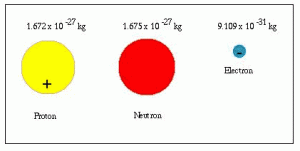SYDNEY J. FREEDBERG JR.
 SPACE & MISSILE DEFENSE SYMPOSIUM, HUNTSVILLE, ALA.: Imagine a technology that could detect roadside bombs and landmines buried underground, pick out a nuclear warhead from a cloud of decoys miles away, or even fry enemy electronics, potentially disarming those warheads from a distance. Well, physicist William Dent has invented that technology and briefed its potential to the Army and industry here. It’s called a neutron beam generator. Dent’s idea is a potential breakthrough for bomb squads and missile defenses, enthused conference organizer David Mann, a three-star Army general who ran Space & Missile Defense Command here (SMDC) until his retirement in 2016. Despite the Star Trek-esque name, Mann told me after Dent’s presentation, this is a feasible real-world technology, a matter of “when, not if.”
SPACE & MISSILE DEFENSE SYMPOSIUM, HUNTSVILLE, ALA.: Imagine a technology that could detect roadside bombs and landmines buried underground, pick out a nuclear warhead from a cloud of decoys miles away, or even fry enemy electronics, potentially disarming those warheads from a distance. Well, physicist William Dent has invented that technology and briefed its potential to the Army and industry here. It’s called a neutron beam generator. Dent’s idea is a potential breakthrough for bomb squads and missile defenses, enthused conference organizer David Mann, a three-star Army general who ran Space & Missile Defense Command here (SMDC) until his retirement in 2016. Despite the Star Trek-esque name, Mann told me after Dent’s presentation, this is a feasible real-world technology, a matter of “when, not if.”
An MRAP (Mine-Resistant Ambush-Protected) truck torn apart by an IED (Improvised Explosive Device)
 Dent is already working with the Army to explore the low-hanging fruit: detecting buried explosives at a distance. Now, the military already uses neutron generators for this, because neutrons easily penetrate most materials (they have no electric charge to interact with and a lot of mass to give them momentum) but will stop and generate a distinctive burst of gamma rays when they hit high-density materials like explosives. The problem with current systems is their range is very short, anywhere from one meter to 20-plus depending on the size of the explosive and the depth to which it’s buried.
Dent is already working with the Army to explore the low-hanging fruit: detecting buried explosives at a distance. Now, the military already uses neutron generators for this, because neutrons easily penetrate most materials (they have no electric charge to interact with and a lot of mass to give them momentum) but will stop and generate a distinctive burst of gamma rays when they hit high-density materials like explosives. The problem with current systems is their range is very short, anywhere from one meter to 20-plus depending on the size of the explosive and the depth to which it’s buried.
Why? Traditional neutron generators shoot off neutrons indiscriminately in all directions, the same way a light bulb emits light. That means the neutrons spread out rapidly, in fact exponentially (specifically, divide strength at the source by the square of the distance). Very soon, there are too few of them hitting any particular target to trigger enough gamma radiation to detect.
Dent’s electron beam generator, however, shoots out all its electrons along the same path, like a laser beam. (It’s worth noting that getting neutrons to line up obediently like this is an extraordinary achievement in physics; more on that below). As a result, the number of neutrons hitting the target stays high even at a distance. Just how far depends on the power you put in and the quality of your aiming system.
How long a range is Dent talking about? “Many, many kilometers,” he told me and another reporter after his presentation. The individual neutrons cross that distance at a respectable 14 percent of the speed of light, about 94 million miles per hour. And that’s with a system of manageable size: neutron beam generator, aiming system, and power supply should add up to no more than “a few hundred pounds,” he said.
Safeguard missile defense site in Nekoma, North Dakota
 Those numbers make the neutron beam generator practical for a wide range of military applications. While detecting roadside bombs is the most near-term possibility, a high-power version of the same technology could be mounted on aircraft or even satellites, something he’s discussing with Army Space & Missile Defense Command here.
Those numbers make the neutron beam generator practical for a wide range of military applications. While detecting roadside bombs is the most near-term possibility, a high-power version of the same technology could be mounted on aircraft or even satellites, something he’s discussing with Army Space & Missile Defense Command here.
Like high explosives, nuclear warheads are extremely dense, made of plutonium or uranium. So, like conventional explosives, nuclear explosives are dense enough to stop neutrons that would go through most ordinary materials, and once the neutrons hit, they generate a distinctive burst of gamma rays. By zapping incoming radar contacts with neutron beams, missile defenders could tell which were decoys and which were real warheads, allowing them to target the real threat.
At even higher power levels, the neutron beam generator could also disable electronics. High-energy neutrons, it turns out, do nasty things to materials like the silicon used in computer chips or the gallium used in radars. It’s rather like a neutron bomb, except you can aim it at one target instead of blasting everything indiscriminately. (There are other aimable electronics-killing technologies out there as well, like high-powered microwaves, but the range is much shorter).
So, I asked, could a sufficiently high-powered neutron beam not just detect a nuclear warhead from a distance, but actually disable it? Dent, who worked on the Safeguard missile defense system as a young Army officer and later on Reagan’s Star Wars initiative for SAIC, pondered a moment.
Then he said: “Could it fry the electronics ? Yes, it could.”
And is that just a theory, I asked afterwards, or something you’re actively working on? The answer: He’s working on it.
Electrons, protons, and neutrons in an atom (highly simplified and abstracted).
The Physics: Rats and Rhinos
 Neutrons are not user-friendly particles, so getting them to line up politely and all go in one direction is a remarkable feat of physics. If electrons are the rats of the subatomic world — small, fast, highly reactive to stimuli, and able to sneak in almost anywhere — then neutrons are rhinoceroses: big, unresponsive to most stimuli, slow to get going, but once in motion almost impossible to stop.
Neutrons are not user-friendly particles, so getting them to line up politely and all go in one direction is a remarkable feat of physics. If electrons are the rats of the subatomic world — small, fast, highly reactive to stimuli, and able to sneak in almost anywhere — then neutrons are rhinoceroses: big, unresponsive to most stimuli, slow to get going, but once in motion almost impossible to stop.
(Why? Electrons have a large electrical charge but very little mass, making them easy to “grab into” electromagnetically, while neutrons have a large mass but no charge, making them the subatomic equivalent of a bowling ball with no finger holes).
Our civilization runs on electricity because electrons are tractable: Magnetic fields and copper wires are basically the Pied Piper for electrons, able to make the rats scurry wherever we want them to go. But neutrons are intractable: What Dent has done is invent the Pied Piper for rhinoceroses.
How Dent directs the neutrons is an exercise in arcane quantum mechanics. Since a neutron has no electric charge, you can’t direct it with electromagnetic fields the way you can direct a charged particle, such as electron or a proton. But neutrons split off from atoms (in this case, from the atomic nucleus formed when deuterium and tritium undergo fusion in a particle accelerator). And you can give an atom a charge (by adding or subtracting electrons). So instead of manipulating the neutrons themselves, you manipulate the parent atoms to make sure the neutrons they emit go in the right direction.
Specifically, an atomic particle spins on its axis, like a top. If that particle undergoes a nuclear reaction and splits off another, smaller particle, the spin of the parent determines the spin of the child. (In mathematical terms, spin is a conserved quantity). Normal neutron generators shoot neutrons in all directions because the atoms generating the neutrons are all spinning in different directions. But if you can line up atoms so they’re all spinning in the same direction, you can predict the direction of any new particles they spin off. That is how Dent aims neutrons.
Relative mass and charge of protons, neutrons, and electrons.
 Readers with a background in either science or science fiction might realize what we’re taking about is a form of particle beam. But experimental particle beams in the real world generally shoot charged particles, which are easier to aim than neutrons but which are also more massive also interact much more with the atmosphere, slowing them down. Those resistances require a lot of power to overcome. Since the neutron beam generator shoots neutrons, which have no charge and don’t interact with anything less dense than high explosives, it takes much less energy to propel them a long distance.
Readers with a background in either science or science fiction might realize what we’re taking about is a form of particle beam. But experimental particle beams in the real world generally shoot charged particles, which are easier to aim than neutrons but which are also more massive also interact much more with the atmosphere, slowing them down. Those resistances require a lot of power to overcome. Since the neutron beam generator shoots neutrons, which have no charge and don’t interact with anything less dense than high explosives, it takes much less energy to propel them a long distance.
Finally, why go to all this trouble to generate neutrons to detect conventional and nuclear explosives? Readers might wonder why we can’t detect nuclear weaponsfrom long range already. But contrary to myth, nuclear warheads aren’t particularly radioactive compared to, say, granite or bananas. So you can’t detect nukes from a distance with a Geiger counter — at least not until they detonate, which is rather too late.
No comments:
Post a Comment